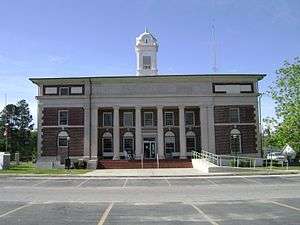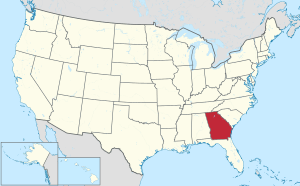Atkinson County, Georgia
Atkinson County is a county located in the southeastern portion of the U.S. state of Georgia. As of the 2010 census, the population was 8,375.[1] The county seat is Pearson.[2] The county was formed in 1917 from parts of Coffee and Clinch Counties. It is named for William Yates Atkinson, Democratic governor of Georgia from 1894 to 1898.[3] In 2003 it had the highest illiteracy rate of any U.S. county at 36%.[4]
Atkinson County | |
|---|---|
 Atkinson County Courthouse in Pearson | |
 Location within the U.S. state of Georgia | |
 Georgia's location within the U.S. | |
| Coordinates: 31°17′N 82°52′W | |
| Country | |
| State | |
| Founded | August 15, 1917 |
| Named for | William Yates Atkinson |
| Seat | Pearson |
| Largest city | Pearson |
| Area | |
| • Total | 345 sq mi (890 km2) |
| • Land | 339 sq mi (880 km2) |
| • Water | 5.2 sq mi (13 km2) 1.5%% |
| Population | |
| • Estimate (2019) | 8,165 |
| • Density | 25/sq mi (10/km2) |
| Time zone | UTC−5 (Eastern) |
| • Summer (DST) | UTC−4 (EDT) |
| Congressional district | 8th |
| Website | www |
Geography
According to the U.S. Census Bureau, the county has a total area of 345 square miles (890 km2), of which 339 square miles (880 km2) is land and 5.2 square miles (13 km2) (1.5%) is water.[5]
The vast majority of Atkinson County is located in the Satilla River sub-basin of the St. Marys-Satilla River basin. The entire narrow western border area, in a line parallel to the western border and running through Willacoochee, is located in the Alapaha River sub-basin of the Suwannee River basin. A small southeastern corner of the county is located in the Upper Suwannee River sub-basin of the same Suwannee River basin.[6]
Major highways
Adjacent counties
- Coffee County - north
- Ware County - east
- Clinch County - south
- Lanier County - southwest
- Berrien County - west
Demographics
| Historical population | |||
|---|---|---|---|
| Census | Pop. | %± | |
| 1920 | 7,656 | — | |
| 1930 | 6,894 | −10.0% | |
| 1940 | 7,093 | 2.9% | |
| 1950 | 7,362 | 3.8% | |
| 1960 | 6,188 | −15.9% | |
| 1970 | 5,879 | −5.0% | |
| 1980 | 6,141 | 4.5% | |
| 1990 | 6,213 | 1.2% | |
| 2000 | 7,609 | 22.5% | |
| 2010 | 8,375 | 10.1% | |
| Est. 2019 | 8,165 | [7] | −2.5% |
| U.S. Decennial Census[8] 1790-1960[9] 1900-1990[10] 1990-2000[11] 2010-2019[1] | |||
2000 census
As of the census of 2000, there were 7,609 people, 2,717 households, and 1,980 families living in the county. The population density was 22 people per square mile (9/km²). There were 3,171 housing units at an average density of 9 per square mile (4/km²). The racial makeup of the county was 66.79% White, 19.61% Black or African American, 0.37% Native American, 0.12% Asian, 0.03% Pacific Islander, 12.03% from other races, and 1.06% from two or more races. 16.95% of the population were Hispanic or Latino of any race.
There were 2,717 households out of which 38.80% had children under the age of 18 living with them, 55.10% were married couples living together, 12.80% had a female householder with no husband present, and 27.10% were non-families. 23.30% of all households were made up of individuals and 9.10% had someone living alone who was 65 years of age or older. The average household size was 2.78 and the average family size was 3.27.
In the county the population was spread out with 30.30% under the age of 18, 10.90% from 18 to 24, 29.60% from 25 to 44, 19.90% from 45 to 64, and 9.30% who were 65 years of age or older. The median age was 31 years. For every 100 females there were 98.00 males. For every 100 females age 18 and over, there were 97.40 males.
The median income for a household in the county was $26,470, and the median income for a family was $32,688. Males had a median income of $24,763 versus $18,434 for females. The per capita income for the county was $12,178. About 18.10% of families and 23.00% of the population were below the poverty line, including 27.10% of those under age 18 and 31.00% of those age 65 or over.
2010 census
As of the 2010 United States Census, there were 8,375 people, 2,983 households, and 2,159 families living in the county.[12] The population density was 24.7 inhabitants per square mile (9.5/km2). There were 3,522 housing units at an average density of 10.4 per square mile (4.0/km2).[13] The racial makeup of the county was 62.2% white, 17.3% black or African American, 0.6% American Indian, 0.3% Pacific islander, 0.3% Asian, 17.7% from other races, and 1.6% from two or more races. Those of Hispanic or Latino origin made up 24.3% of the population.[12] In terms of ancestry, 16.1% were English, 16.0% were Irish, and 7.5% were American.[14]
Of the 2,983 households, 41.2% had children under the age of 18 living with them, 50.3% were married couples living together, 15.3% had a female householder with no husband present, 27.6% were non-families, and 22.9% of all households were made up of individuals. The average household size was 2.80 and the average family size was 3.29. The median age was 33.4 years.[12]
The median income for a household in the county was $33,834 and the median income for a family was $34,859. Males had a median income of $29,286 versus $25,705 for females. The per capita income for the county was $15,456. About 19.8% of families and 28.0% of the population were below the poverty line, including 42.4% of those under age 18 and 21.3% of those age 65 or over.[15]
Education
The county is serviced along with Coffee County, Georgia by the Satilla Regional Library System.
Communities
Cities
Politics
| Year | Republican | Democratic | Third parties |
|---|---|---|---|
| 2016 | 72.0% 1,878 | 26.7% 697 | 1.3% 35 |
| 2012 | 66.7% 1,938 | 32.0% 930 | 1.3% 39 |
| 2008 | 66.8% 1,941 | 32.3% 938 | 1.0% 28 |
| 2004 | 67.4% 1,666 | 32.3% 799 | 0.3% 8 |
| 2000 | 59.3% 1,228 | 39.6% 821 | 1.1% 22 |
| 1996 | 42.9% 784 | 45.1% 823 | 12.0% 219 |
| 1992 | 35.7% 779 | 48.3% 1,056 | 16.0% 350 |
| 1988 | 55.6% 1,126 | 43.8% 887 | 0.6% 12 |
| 1984 | 51.2% 944 | 48.8% 901 | |
| 1980 | 33.6% 747 | 65.2% 1,449 | 1.2% 26 |
| 1976 | 18.2% 347 | 81.8% 1,560 | |
| 1972 | 74.9% 924 | 25.1% 309 | |
| 1968 | 11.4% 288 | 27.1% 686 | 61.5% 1,554 |
| 1964 | 58.8% 1,157 | 41.2% 811 | 0.1% 1 |
| 1960 | 15.6% 239 | 84.5% 1,298 | |
| 1956 | 6.6% 122 | 93.4% 1,719 | |
| 1952 | 11.1% 194 | 88.9% 1,560 | |
| 1948 | 10.2% 114 | 83.8% 938 | 6.1% 68 |
| 1944 | 10.5% 90 | 89.5% 766 | |
| 1940 | 8.6% 66 | 91.3% 703 | 0.1% 1 |
| 1936 | 2.9% 29 | 97.1% 958 | |
| 1932 | 5.2% 41 | 94.2% 747 | 0.6% 5 |
| 1928 | 25.7% 121 | 74.3% 350 | |
| 1924 | 5.7% 25 | 90.4% 394 | 3.9% 17 |
| 1920 | 20.8% 119 | 79.2% 453 |
References
- "State & County QuickFacts". United States Census Bureau. Archived from the original on July 6, 2011. Retrieved June 17, 2014.
- "Find a County". National Association of Counties. Archived from the original on 2011-05-31. Retrieved 2011-06-07.
- Krakow, Kenneth K. (1975). Georgia Place-Names: Their History and Origins (PDF). Macon, GA: Winship Press. p. 8. ISBN 0-915430-00-2.
- "State and County Literacy Estimates - State Estimates". nces.ed.gov. Retrieved 2018-03-18.
- "US Gazetteer files: 2010, 2000, and 1990". United States Census Bureau. 2011-02-12. Retrieved 2011-04-23.
- "Georgia Soil and Water Conservation Commission Interactive Mapping Experience". Georgia Soil and Water Conservation Commission. Retrieved 2015-11-27.
- "Population and Housing Unit Estimates". Retrieved May 21, 2020.
- "U.S. Decennial Census". United States Census Bureau. Retrieved June 17, 2014.
- "Historical Census Browser". University of Virginia Library. Retrieved June 17, 2014.
- "Population of Counties by Decennial Census: 1900 to 1990". United States Census Bureau. Retrieved June 17, 2014.
- "Census 2000 PHC-T-4. Ranking Tables for Counties: 1990 and 2000" (PDF). United States Census Bureau. Retrieved June 17, 2014.
- "DP-1 Profile of General Population and Housing Characteristics: 2010 Demographic Profile Data". United States Census Bureau. Archived from the original on 2020-02-13. Retrieved 2015-12-27.
- "Population, Housing Units, Area, and Density: 2010 - County". United States Census Bureau. Archived from the original on 2020-02-13. Retrieved 2015-12-27.
- "DP02 SELECTED SOCIAL CHARACTERISTICS IN THE UNITED STATES – 2006-2010 American Community Survey 5-Year Estimates". United States Census Bureau. Archived from the original on 2020-02-13. Retrieved 2015-12-27.
- "DP03 SELECTED ECONOMIC CHARACTERISTICS – 2006-2010 American Community Survey 5-Year Estimates". United States Census Bureau. Archived from the original on 2020-02-13. Retrieved 2015-12-27.
- Leip, David. "Dave Leip's Atlas of U.S. Presidential Elections". uselectionatlas.org. Retrieved 2018-03-18.
External links
- list of places
- Atkinson County Sheriff's Office
- Atkinson County historical marker
